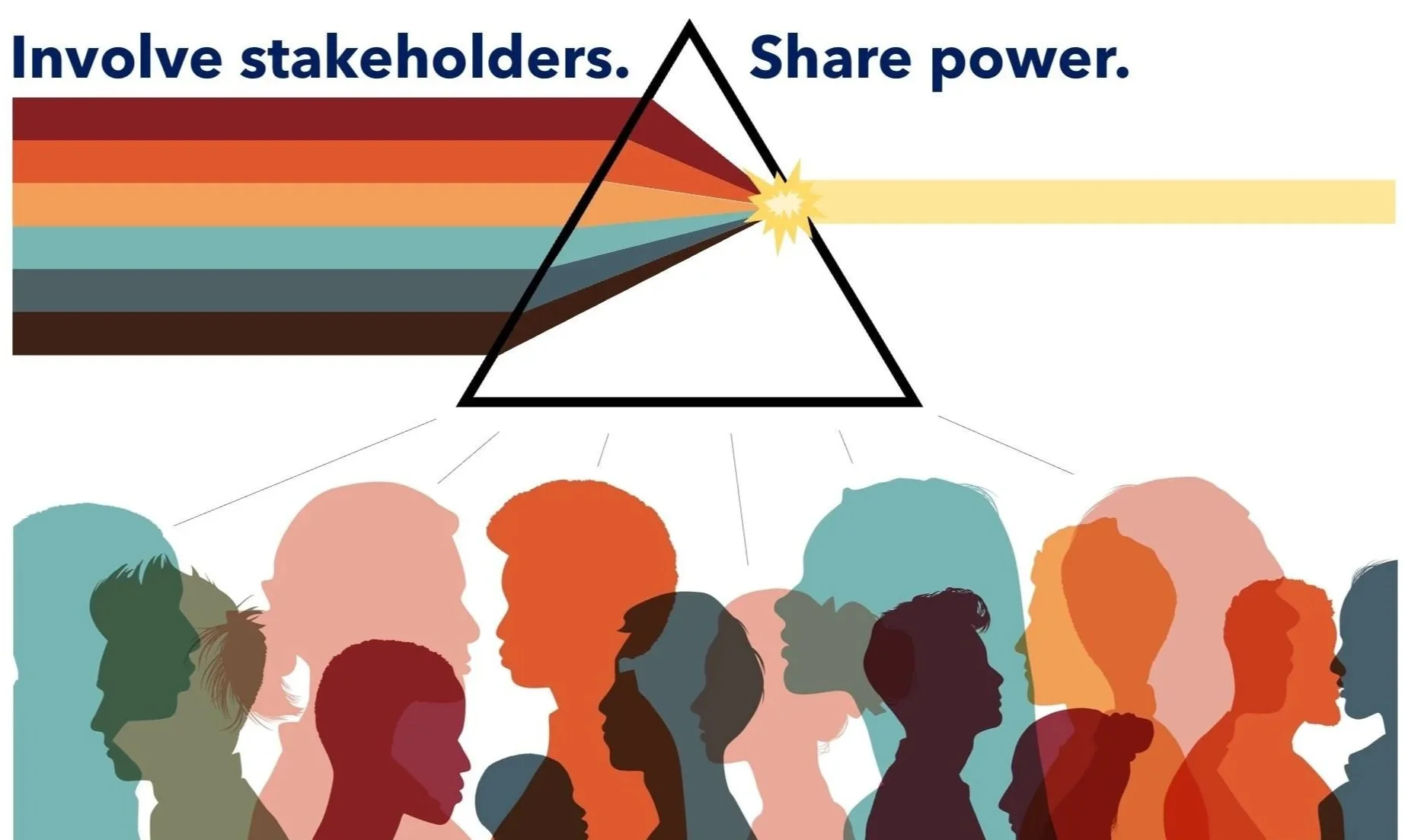Moving Beyond Trust to Shared Power
Joe Tolbert Jr.
Figure 1. “Involve stakeholders. Share power.”
Like many Black professionals in our field, I got my start at a Black community based arts organization. The Carpetbag Theatre, Inc. was started in 1969 during the Black Arts Movement. The theater company devised work from community stories with the mission of unleashing the hidden wisdom of communities that have been silenced by oppressive systems. Looking back on the time I spent as an employee at Carpetbag, we experienced a lot of ebbs and flows of funding, which meant we were always adjusting project scopes to fit the whims of our funders. The amount of money philanthropy thought best fit our work, rarely fit the needs of our communities.
One of the most memorable lessons I received from learning about the history of the Black Arts Movement, that gave rise to Carpetbag, is the right to self-determination. Those historic leaders strategized for the autonomy to address the concerns of their communities in the ways that they deemed best. They wanted to create art that speaks directly to Black people and that challenged the status quo politics of the time. I often find myself asking what Carbetbag’s trajectory might have been had foundations invested from a place of community determination instead of assuming they knew what our community needed and deserved. The call for trust based philanthropy is a first step, and I am happy that calls for trust based philanthropy are yielding shifts in practices around reporting and general operating support, but do you truly trust communities if you don’t trust them to practice self determination?
Figure 2. “The phenomenon of disability-friendly features benefitting and being used by a larger group than the people they were designed for.”
As we delve deeper into the polycrisis of environmental and economic collapse, do we genuinely believe that repeating the approaches of the past will generate a different outcome? The rupture in which we’re living is an opportunity for us to reimagine, redesign, and begin to practice new systems in support of culture. To do so in a way that centers the voices, experience, and needs of Black artists with the understanding that if we design for those in the margins, everyone benefits (e.g., the curb cut effect, see Figure 2). The field needs to reimagine the policies and practices of arts and culture philanthropy from one of charity to one of investment and shared power.
I posit, the transition from trust based philanthropy to shared power might look like:
Community Members as Strategy Architects
In the United States, we aren’t taught to see artists’ work as valuable. We treat artists as the creators of beautiful things, entertainment, but the process of making art holds value beyond the end product. As people concerned with the public good, philanthropy can’t continue assuming the role of the expert. What possibilities emerge for communities when they are invited and resourced to design philanthropic strategy and programs?
An Invitation into Governance
The assets foundations hold have been extracted from our communities through exploitation. Another way to move toward shared power is by involving the communities in governance structures. The boards of foundations often mirror the capitalist elite circles that have built their wealth from capitalist extraction of people’s labor and resources from the natural world around us. Shared power in this regard can look like inviting community members to bring to bear their knowledge and lived experience in the rooms where philanthropic power is yielded, policies and investment decisions are made, and priorities are set.
“How many board seats at arts and culture foundations are filled with the community members the foundations seek to serve? Diversifying the boards of philanthropy and inviting people from community is a reparative measure to the practices of extraction of labor and natural resources. This will allow communities to influence the direction foundations take, making a pathway to community determination.”
With the rolling back of 2020 era support to Black artists and arts organizations, now is not the time to maintain status quo policies and practices that limit the community’s ability to practice self determination. Now is a time for imagination and the planting of seeds that will move us forward toward justice, so that every Black artist and Black arts organization can continue to create dangerously.
ABOUT THE AUTHOR
Joe Tolbert Jr., Executive Director is a cultural strategist and facilitator dedicated to strengthening creative ecosystems in Appalachia. As Executive Director of the Waymakers Collective, he leads initiatives that expand opportunities for artists and cultural practitioners while advocating for sustainable investment in the arts. With degrees from the University of Tennessee, Knoxville, and Union Theological Seminary, Joe’s leadership has been recognized through fellowships with National Arts Strategies and the Intercultural Leadership Institute. His work focuses on fostering innovation, securing fair access to resources, and empowering artists to drive cultural growth. Through his strategic leadership, Joe continues to position Appalachia as a hub for artistic excellence and creative resilience.


